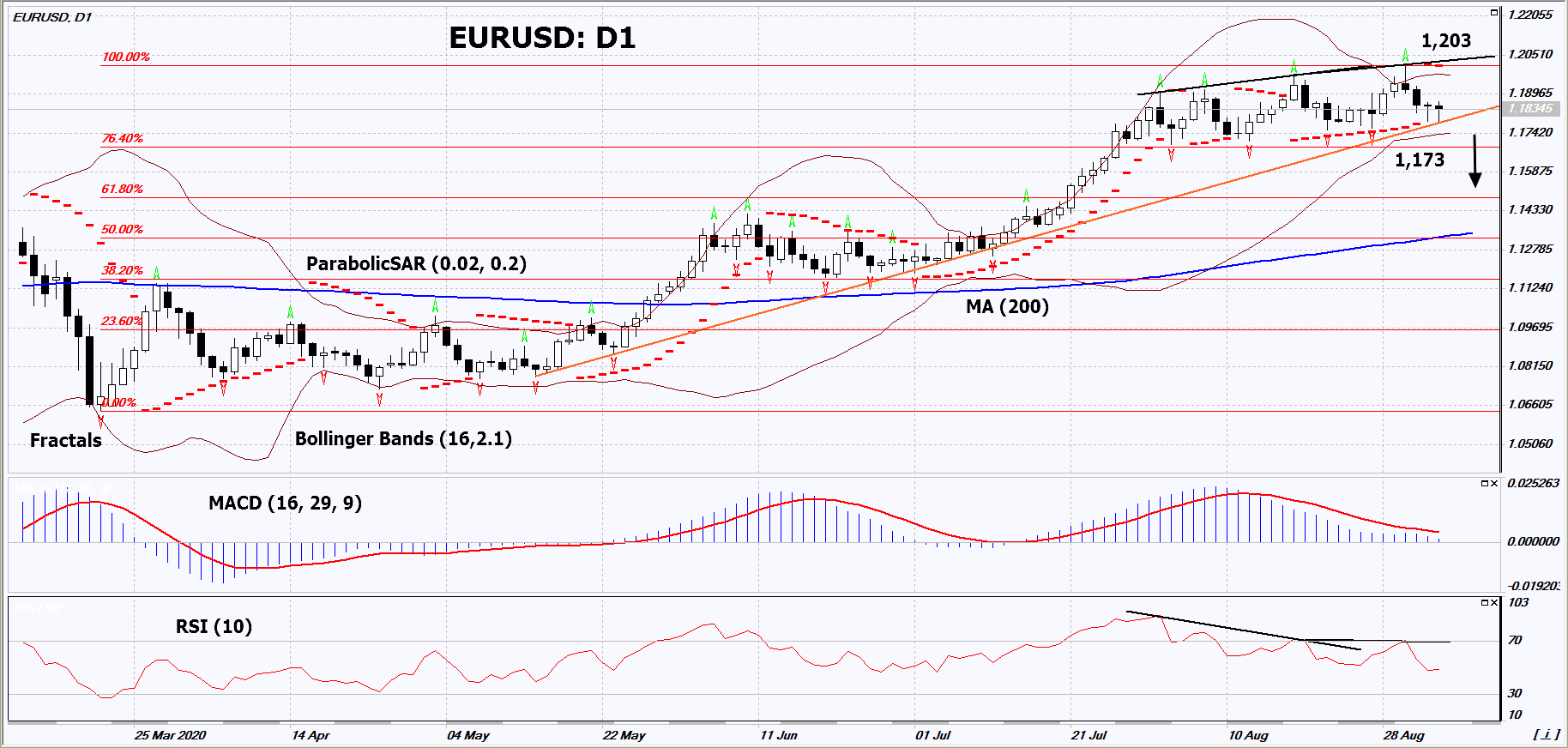- Phân tích dữ liệu
- Phân tích kỹ thuật thị trường
EUR/USD Phân tích kỹ thuật - EUR/USD Giao dịch: 2020-09-07
EUR/USD Tổng quan phân tích kỹ thuật
Dưới 1,173
Sell Stop
Trên 1,203
Stop Loss
| Chỉ thị | Tín hiệu |
| RSI | Bán |
| MACD | Bán |
| MA(200) | Trung lập |
| Fractals | Trung lập |
| Parabolic SAR | Bán |
| Bollinger Bands | Trung lập |
EUR/USD Phân tích biểu đồ
EUR/USD Phân tích kỹ thuật
On the daily timeframe, EURUSD: D1 approached the uptrend support level. It must be broken down before opening a position. A number of technical analysis indicators show signals of further growth. We do not exclude a bearish movement if EURUSD falls below the last 2 lower fractals and the lower Bollinger line: 1.173. This level can be used as an entry point. We can set a stop loss above the Parabolic signal, the upper Bollinger band, the high since April 2018 and the last high fractal: 1.203. After opening a pending order, we can move the stop loss to the next fractal maximum following the Bollinger and Parabolic signals. Thus, we change the potential profit/loss ratio in our favor. After the transaction, the most risk-averse traders can switch to the four-hour chart and set a stop loss, moving it in the direction of the bias. If the price meets the stop loss (1.203) without activating the order (1.173), it is recommended to delete the order: some internal changes in the market have not been taken into account.
Phân tích vĩ mô Forex - EUR/USD
The recovery of the European economy is slowing down after the coronavirus pandemic. Will the euro quotations decline?
Retail sales in the Eurozone fell by 1.3% monthly in July. This is much worse than both forecast of + 1.5%, and their June result of + 5.3%. Retail sales in Germany fell 0.9% month-on-month in July, while a 0.5% rise was expected. In the United States, retail sales grew by 1.2% in July. Industrial orders in Germany increased by 2.8% in July. This is worse than the forecast ( 5%) and the June figure ( 28.8%). Compared to the mid-March rate, EURUSD is now traded 11% higher. Last week, the ECB chief economist Philip Lane expressed concern about the over-strengthening of the European single currency. In theory, given the current low inflation, the ECB may go for additional monetary easing, since they believe that too strong euro reduces the efficiency of European exports. Recall that in August, the Eurozone's consumer prices growth slowed to 0.4% in annual terms from 1.2% in July.
Lưu ý:
Bài tổng quan này mang tính chất tham khảo và được đăng miễn phí. Tất cả các dự liệu trong bài viết được lấy từ các nguồn thông tin mở và được công nhận đang tin cậy. Nhưng không có bất kỳ đảm bảo nào rằng thông tín hoàn toàn đang tin cậy. Sau này không điều chỉnh lại nữa. Tất cả thông tin trong bài tổng quan, bao gồm ý kiến, chỉ số, biểu đồ và khác chỉ mang tính chất tham khảo và không phải là lời khuyên đầu tư. Tất cả bài viết này không được xem xét như lời khuyên thúc đẩy để giao dịch. Công ty IFC Markets và nhân viên không chịu trách nghiệm cho bất kỳ quyết định của khách hàng sau khi đọc xong bài tổng quan.


